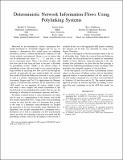Deterministic network information flows using polylinking systems
Author(s)
Goemans, Michel X.; Iwata, Satoru; Zenklusen, Rico
DownloadGoemans_Deterministic network.pdf (54.80Kb)
PUBLISHER_POLICY
Publisher Policy
Article is made available in accordance with the publisher's policy and may be subject to US copyright law. Please refer to the publisher's site for terms of use.
Terms of use
Metadata
Show full item recordAbstract
Motivated by the deterministic wireless information flow model introduced by Avestimehr, Diggavi and Tse, we introduce a deterministic flow model based on combining polylinking systems, a notion introduced by Schrijver and closely related to polymatroids. Given is a set of vertices that can be partitioned into layers V[subscript 1],..., V[subscript r] and flow is sent across consecutive layers. There is no notion of edges, and how flow can be sent from one layer to the next is described by polylinking systems. Thanks to the abstract nature of polylinking systems, this new model is very general and gives large freedom in specifying how flow can be sent through the network. In particular, the new model includes the classical flow model of Ford and Fulkerson restricted to acyclic graphs as well as a wireless information flow model introduced by Avestimehr, Diggavi and Tse to approximate the Shannon capacity of Gaussian relay networks. In the framework of this ADT model, we can aggregate all vertices within a relay, and obtain a more compact and natural formulation of this model based on our polylinking flow model. This has also the advantage of allowing for non-integral capacities and flows.
Date issued
2010-01Department
Massachusetts Institute of Technology. Department of MathematicsJournal
Proceedings of the IEEE Information Theory Workshop 2010 (ITW 2010)
Publisher
Institute of Electrical and Electronics Engineers (IEEE)
Citation
Goemans, Michel X., Satoru Iwata, and Rico Zenklusen. “Deterministic network information flows using polylinking systems.” In IEEE Information Theory Workshop 2010 (ITW 2010), 1-1. Institute of Electrical and Electronics Engineers, 2010. © 2010 IEEE
Version: Final published version
ISBN
978-1-4244-6372-5